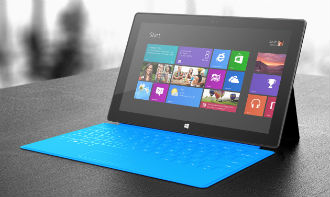 Intel reported its second-quarter earnings on Wednesday and the general consensus is that the numbers were weaker than expected. Net income was down 29 percent, while sales of PC chips, which make up about two thirds of Chipzilla’s revenue, were down 7.5 percent. Sales fell five percent to $12.8 billion, missing analysts’ forecasts by $100 million.
Intel reported its second-quarter earnings on Wednesday and the general consensus is that the numbers were weaker than expected. Net income was down 29 percent, while sales of PC chips, which make up about two thirds of Chipzilla’s revenue, were down 7.5 percent. Sales fell five percent to $12.8 billion, missing analysts’ forecasts by $100 million.
The writing is on the wall for Windows RT
 Over the last week or so we witnessed a flurry of Windows RT news, some positive, some very negative indeed. Late last week Microsoft decided to slash the prices of the Surface RT by as much as $150 in an effort to make the uncompetitive tablet a bit more appealing to the average consumer on the prowl for a cheap media tablet.
Over the last week or so we witnessed a flurry of Windows RT news, some positive, some very negative indeed. Late last week Microsoft decided to slash the prices of the Surface RT by as much as $150 in an effort to make the uncompetitive tablet a bit more appealing to the average consumer on the prowl for a cheap media tablet.
In June, Microsoft announced that it would release Outlook 2013 for Windows RT tablets, which is clearly an attempt to gain a bit more traction in the enterprise segment. The decision not to include Outlook in Windows RT at launch was baffling, and still is. The first reviews of Outlook 2013 for RT are in and they are positive, but it really should have been included months ago. With the upcoming 8.1 update, it should land on all RT devices, provided there are still RT devices by the time it appears.
This is no laughing matter, the lack of actual Windows RT products is becoming a serious concern. For example, Lenovo has just dropped the Yoga 11 convertible from its web shop. Dell and Asus have also slashed the prices of their RT tablets. Some players like HP ignored Windows RT altogether, while some gave it a go and dropped it, like Samsung. What’s more, all vendors are focusing on proper Windows 8 tablets instead, based on x86 chips.
In fact, the only hardware maker that still seems to be taking Windows RT seriously is Microsoft itself. The Surface RT price cut is a way of clearing inventory and making room for the next generation Surface RT, or a couple of them. At this point it seems that Microsoft is working on two different designs. One is reportedly based on the Qualcomm Snapdragon 800 SoC, while the other one will be powered by Nvidia’s Tegra 4. Rumours of a smaller Surface RT have been floating around for months and there is a good chance Microsoft will roll out a 7- to 8-inch design along with a new full-size 10.6-incher.
Unfortunately it seems to be too late. Future Windows RT tablets, including the Surface RT in both rumoured flavours, will now have to compete with tablets based on Intel’s new Bay Trail chips. This was not the case last year, when the Surface RT was opposed solely by ARM based Androids and iPads. Now it will face tough in-house competition in the form of Windows 8.1 tablets powered by Intel’s x86 Atoms. What’s more, Bay Trail is shaping up to be a beast. It is said to be faster than the Snapdragon 800 and it doesn’t need much power, either.
With new x86 SoCs from Intel and AMD coming online, it is hard to see why Microsoft would want to stick with a specialized tablet OS, designed for ARM. The next generation of Windows 8.x tablets is expected to end up a lot cheaper than the first generation, leaving very little wiggle room for Windows RT. Small wonder then that many brands aren’t getting on board, since they seem to believe Windows RT will be dead as disco within a generation or two.
It seems that the only practical way to keep Windows RT alive in the long run is to stick it on dirt cheap tablets designed to take on bargain Androids in the 7- to 8-inch range. This probably won’t work, as Windows RT is rather bloated and it’s far too expensive to make sense on such cheap devices, unless Microsoft agrees to practically give it away for free. Since we are talking about Microsoft, this will happen when hell freezes over. In theory at least, Microsoft could keep Windows RT alive, but we’re really not sure it should.
Brits wary of trusting bosses with data
 Most employees don’t trust their bosses to keep private information private – or even not to use it against them in any way, according to a survey.
Most employees don’t trust their bosses to keep private information private – or even not to use it against them in any way, according to a survey.
But there is confusion about how much information their employers are able to see generally, with 41 percent of respondents thinking bosses are not able to see anything at all on their personal devices. MobileIron and Vision Critical, which ran the survey, warn that in reality, if devices are used for corporate email, it is possible for employers to see their emails and attachments on mobile devices just as easily as on a PC.
Respondents were worried the most about employers being able to access personal email and attachments, texts and personal contacts. This is very unlikely, but it is possibly to see the make, model and OS of a device, the IMEI, phone number, a complete list of apps installed, the device’s location, battery level, storage capacity, corporate email and attachments and corporate contacts.
Employers are unable to see information contained in apps, unless the app has been set up to send information to the corporate server. Personal emails, attachments, texts, photos, videos, voicemails and web browsing activity should all be safe.
But the fact employees are worried about such access shows a certain level of distrust in business. MobileIron says the key to winning over employee trust is clear communication – with respondents saying they would be keen to understand in detail the purpose of seeing device information and how that is separated from work.
However, 20 percent of respondents said they wanted employers to ask for written consent before they were able to access anything on a personal device, and 18 percent would like written notification about exactly what their bosses can and can’t see.
The survey was carried out in the US, the UK and Germany and talked to just shy of 3,000 randomly selected employed adults. Respondent data shows young workers were more savvy about privacy concerns more than any other identifier.
Brits were the most cynical, with 36 percent agreeing there is “nothing” employers can do to increase trust on privacy.
Businesses ignore BYOD best practice
 Acronis and the Ponemon Institute have published the results of a joint survey that suggests most businesses are putting their data at risk because they don’t have the correct policies in place.
Acronis and the Ponemon Institute have published the results of a joint survey that suggests most businesses are putting their data at risk because they don’t have the correct policies in place.
Most common was a lack of personal device policies – and even among those that did have these policies, executives were exempted, despite the fact they could be handling the most sensitive company data.
A quarter of those surveyed are, the report says, in “denial” about BYOD trends. 23 percent still forbid personal devices from being on the network.
Alarmingly, almost 80 percent of surveyed organisations haven’t bothered to educate their employees on BYOD privacy risks let alone best practice.
Just 18 percent performed remote device wipes when employees moved on from the company. Similarly, 21 percent required a device password or key lock on these devices.
Businesses are also using public cloud services like Dropbox to store and share corporate data, and many don’t have policies in place for public cloud either. Most of the surveyed companies hadn’t trained employees how to properly use public cloud services.
Acronis’ MD for UK&I, Rick Powles, said that while the BYOD trend is an opportunity for companies, many are negligent. “With policies that manage the flow of data between multiple devices and environments, companies can practice safe BYOD with confidence,” Powles said.
Over 4,000 IT managers were surveyed around the world.
Seagate thinks SSDs and HDDs can coexist
 Now that it has started peddling solid-state drives of its own, Seagate seems to think there is plenty of room for SSDs and HDDs to coexist, with hybrid drives serving like a buffer of sorts.
Now that it has started peddling solid-state drives of its own, Seagate seems to think there is plenty of room for SSDs and HDDs to coexist, with hybrid drives serving like a buffer of sorts.
In other words, hybrid drives will be the equivalent of Belgium or Bosnia, which means they don’t exactly have a bright future in the long run. Sooner or later SSDs will come knocking at their door.
In an interview with the Korea Herald, Seagate VP Banseng Teh said the future of storage lies not in hard drives or unit sales, but in storage capacity. Commenting on reports that Samsung might ditch its desktop PC business, Teh said such a turn of events wouldn’t have much of an impact on Seagate. It is worth noting that Samsung has denied that it is pulling out of desktops.
“The volume of what we ship to desktop makers including Samsung is admittedly retreating, but this trend does not affect us because it is not about the units we ship, but the capacity,” Teh said.
Teh believes that annual storage shipments will grow 20 fold by capacity by 2020, which sounds quite optimistic. Desktops might not be the driving force behind hard drive sales, but other form factors and new devices should take their place.
Hard drives will not only get bigger, they will get smarter, too. Teh believes that over 85 percent of hard drives will eventually incorporate hybrid technology. In addition, SSD penetration in notebooks should hit 33 percent by 2016, with a CAGR of 162.4 percent between 2011 and 2016.
However, SSD remain prohibitively expensive and they won’t replace mechanical drives anytime soon. That is why Seagate and other hard drive makers are focusing on hybrid drives in the interim.
“Besides being impractical, a sudden surge in investment would likely plunge the semiconductor industry into a massive slump,” Teh said. “Our goal and strategy is to provide the broadest range of options for our customers, be it SSDs, hybrid or hard disk drives, based on their computing needs.”
European car sales plummet to 20-year low
 European car sales have gone off a cliff yet again. Reuters is reporting that the first half of 2013 was the worst for carmakers in two decades and it seems to be getting worse, as sales in June dropped 6.3 percent.
European car sales have gone off a cliff yet again. Reuters is reporting that the first half of 2013 was the worst for carmakers in two decades and it seems to be getting worse, as sales in June dropped 6.3 percent.
With record unemployment in Europe and youth unemployment over 50 percent in some EU countries, the figures are hardly surprising.
The industry is also facing a host of other problems and overcapacity is one of them. Fiat and Peugeot seem to have gotten the worst of it, dropping 13.6 and 10.9 in June respectively.
It’s hardly surprising, as both outfits are running on fumes and selling outdated hatchbacks – both the 308 and Bravo are long overdue for replacement, along with the venerable Punto. The plucky Peugeot 208 is off to a good start, though.
Ford was an exception with a 6.9 percent rise in sales and the Volkswagen Group is still hanging in there, thanks to a fresh range of hatchbacks based on the new MQB platform. However, Audi was down 8.9 percent.
Car registrations in EU and EFTA countries fell 6.7 percent last month to 6,436,743, the lowest monthly total since 1993. IHS Automotive believes the market has bottomed out, but it’s still too early for anything resembling a recovery. In a recent interview BMW CEO Norbert Reithofer said things probably wouldn’t get better until at least the middle of 2014.
Even the mighty German market, which bucked the negative trend in recent years, shrank 4.7 percent in June. Sales in France and Italy dropped 8.4 and 5.5 percent respectively and we don’t even want to mention Spain and Greece.
However, Britain soldiers on with the sixteenth straight month of gains. Sales in June were up 13.4 percent, which is rather surprising.
Online sales growth hits new high
 The online retail market in the UK is still going strong and according to IMRG Capgemini’s latest figures it is growing at the fastest rate in two years. IMRG Capgemini’s e-Retail Sales Index found that June sales rose 20 percent year-on-year. Furthermore monthly sales in June were better than in May for the first time in five years.
The online retail market in the UK is still going strong and according to IMRG Capgemini’s latest figures it is growing at the fastest rate in two years. IMRG Capgemini’s e-Retail Sales Index found that June sales rose 20 percent year-on-year. Furthermore monthly sales in June were better than in May for the first time in five years.
IMRG CIO Tina Spooner said the market has beaten expectations this year, with 16 percent growth in the first half of the year, beating the outfit’s earlier forecast of 12 percent. Mobile transactions are also doing well, up 136 percent year-on-year in June.
“Mobile commerce continues to power on in 2013. More specifically, the mobile conversion rate has increased from 1.27% in June 2012 to 2.03% in June 2013 which is a very positive signal that mobile commerce is achieving serious traction in the UK market,” said Oliver Ripley, mobile product manager at eCommera.
Ripley pointed out that modern retailers are investing more in mobile commerce storefronts, both through browsers and bespoke apps. The shopping experience is getting better for mobile users, with improved payment services and user interface improvements.
Ripley also noted that consumers are becoming more used to mobile transactions and this is especially true of younger consumers.
Chris Webster, VP, Head of Retail Consulting and Technology at Capgemini said the uplift experienced this month will provide retailers with a note of cheer.
“With the Index recording its biggest year-on-year growth since June 2011 and Q2 being 17% up on Q2 2012. This is in stark contrast to the continued decline in store footfall reported by the BRC over the first half of the year and amplifies the increase of online at the expense of store sales,” he said. “In addition, Britons remain price-conscious, but have responded well to good deals found online and it’s good to see consumer confidence returning.”
Inflation rate approaches three percent
 The Consumer price index (CPI) inflation rate grew to 2.9 percent in June, an increase on May’s 2.7 percent, the Office for National Statistics has announced – approaching the Bank of England’s cut-off point of three percent.
The Consumer price index (CPI) inflation rate grew to 2.9 percent in June, an increase on May’s 2.7 percent, the Office for National Statistics has announced – approaching the Bank of England’s cut-off point of three percent.
Slower rises in food prices and air fare managed to keep the lid on the inflation rate, which was expected because of increases in clothing and petrol prices from the same time last year.
Prices in clothing and footwear fell by 1.9 percent between May and June 2013 – much less than the 4.2 percent fall the same time lastyear, which was the largest on record. Transport prices rose 0.1 percent between May and June, compared with a fall of 0.5 percent for the same period last year.
Petrol prices rose by 1.0 pence per litre, compared with a 4.3 pence decline last year. Diesel was also up, but air fares fell 2.8 percent compared with a 7.4 percent rise in 2012.
The largest downward effects came from food and non-alcoholic beverages, with prices dropping 0.5 percent compared to a small fall of 0.1 percent last year. Recreation & culture saw prices drop 0.2 percent compared to 0.1 percent the previous year, with the main effect coming from package holidays.
The pound fell three quarters of a cent compared to the dollar at roughly $1.506, the BBC reports.
Berenberg Bank analyst Rob Wood told auntie that inflation is “likely to bobble around three percent for the next few months before heading down towards the two percent target next year, as weak wage growth feeds through to lower costs and inflation”.
But chief economist at the British Chambers of Commerce, David Kern, said there is uncertainty whether inflation will peak before falling later this year, as expected.
“If this happens it is still possible that the recovery will continue to slowly gather momentum throughout the year and into 2014,” he said, adding that unexpected developments like surges in energy prices could push inflation. This would mean “our growth prospects will face new risks”, he said.
The Bank of England’s target is to keep CPI around the two percent mark. If CPI pushes past three percent, governor Mark Carney must speak with chancellor George Osborne.
Good weather boosts June footfall, high street gets the best of it
 Retail footfall in June was up 0.1 percent year-on-year, reversing the negative trend in May, which saw a 0.7 drop. Good weather seems to be the main factor, as high street footfall was up 1.4 percent while out of town footfall was up 0.6 percent.
Retail footfall in June was up 0.1 percent year-on-year, reversing the negative trend in May, which saw a 0.7 drop. Good weather seems to be the main factor, as high street footfall was up 1.4 percent while out of town footfall was up 0.6 percent.
However, according to the British Retail Consortium, footfall in shopping centres dropped three percent following a previous drop of 1.7 percent in May. Looking at the first half of the year, the trend is largely positive, as footfall fell 1.5 percent compared to 2.9 percent during the first six months of 2012.
Greater London did particularly well, with a 2.4 percent spike, followed by Wales with a 2.3 percent increase. Scotland and the West Midlands were up by 1.2 and 1.3 percent respectively. However, footfall in the East Midlands was down 1.9 percent.
“The improvement in the weather may well have contributed to this,” said BRC director general Helen Dickinson. “Our recent retail sales figures showed a strong performance from fashion and footwear and it is likely that shoppers took advantage of the start of the sunshine in June to visit their local high street and buy items for their summer wardrobes.”
However, Springboard pointed out that good performance of high streets also has a lot to do with the fact that they underwent a bigger decline in footfall in previous year, which means they are starting from a lower base.
No qualms for small biz toilet talk
 Small biz owners are increasingly taking important work related calls while sitting on the bog, a company has claimed.
Small biz owners are increasingly taking important work related calls while sitting on the bog, a company has claimed.
Seven out of 10 micro business owners have taken a business call in the toilet, call answering service Penelope found in a survey.
The main reason for taking the calls is for fear of missing out on new business.
Others said they had taken a call at a funeral and slightly less took a work call at a wedding, CRN reports.
Penelope co-founder Ed Reeves said that responsiveness is critical for small businesses.
“A consumer is unlikely to chase a business to buy something from them, it is far more likely that they will simply call someone else,” Reeves said.
Next-gen consoles will struggle
 The next generation of games consoles are expected to pass 133 million shipments in their first five years on the market, slightly down from 140 million for the previous generation.
The next generation of games consoles are expected to pass 133 million shipments in their first five years on the market, slightly down from 140 million for the previous generation.
ABI Research noted that, although the console refresh – with Microsoft’s Xbone and Sony’s PS4 – should inject some life into the market, niche consoles nibbling at their heels could shake it up and encourage more innovation than the big three would like.
New platforms, such as niche Android devices like Ouya and even Nvidia’s curiosity Project Shield, will promote different approaches to gaming. According to a report, new entrants will be able to raise existing platforms like Windows and Android as well as bridging the divide between fixed and mobile gaming.
We could even see low cost consoles emerging out of current generation technology in the $99 or less bracket.
According to senior ABI analyst Michael Inouye, without a shift in strategy Nintendo may suffer – as the casual gamers stick to mobile devices and Wii U pricing fails to bring about the success of the Wii.
Meanwhile, if China – which is mulling lifting a console ban – opens its borders to the big players, there could be a short term boost of current generation consoles, though this is not expected to alter next gen shipments too much.
Practice director Sam Rosen said ultimately, the future of console makers depends on balancing compelling content with competitive pricing.
“Without solid titles and first party franchises, platforms will have a difficult time finding traction, streaming media is not enough when low-cost smart set top boxes are readily available,” Rosen said. “While we don’t anticipate a drop-off in game console households, barring significant changes to less developed console markets in Asia and Latin America, there isn’t a great deal of growth opportunity beyond the current installed base”.
Microsoft way below the Surface
 This week Microsoft announced that it was cutting the price of the ARM based version of its Surface tablets.
This week Microsoft announced that it was cutting the price of the ARM based version of its Surface tablets.
Instantly it kicked itself an own goal with many of the more cynical types in the industry saying that it was a fire sale which HP did when its tablet failed.
Both were trying to do something fairly radical. HP was trying to convince the world that its WebOS was up to snuff and Microsoft was trying to tell the world that it could run on ARM chips.
HP ended up flogging its warehouses in a fire sale and no the thought is that Microsoft has done the same.
There are some similarities between the HP situation and what Microsoft is doing now, but it is not to do with a fire sale. Microsoft did make a number of mistakes when it came to its Surface and not it is trying to repair that error.
The biggest error Microsoft did was on an increasing saturated market it attempted to launch a product at a price which was far too high to push it into the market.
It also initially launched a product based around ARM which could not do half the things that the x86 version could manage.
At the time there was a good rumour that Microsoft was going to release its keyboard based Surface at about $100 to $150 lower than Apple. This would have to be subsidised, but would certainly have proved popular and could have gotten Vole’s foot in the door.
However Microsoft decided instead not to do that. In fact there was some indications that Microsoft CEO Steve Ballmer did not want to hack off his OEMs too much by releasing a cut price tablet which would have knocked them out of the market.
After coming into the market late, and with a product that was going to be overpriced and a tough sell, Microsoft did not do too badly. However the figures did leave Microsoft with shedloads of overpriced tablets sitting in its warehouse.
The answer to this was to come in late with price cuts and hope that cheap and cheerful RTs would encourage future upgrades to the concept later.
But typically with things Microsoft, it mis-handled the whole thing. What Microsoft wanted to do was issue a new range of Surface tablets with a better spec. It wanted to empty its warehouses so it could introduce a better selling model.
If it were Apple it would start the world talking about the new spec first. Then no one would question what the price cuts were all about. Those who wanted the new machines would wait, while those who did not care too much about future proofing would believe they had a good deal.
But Microsoft kept the news of its new tablets quiet until after the cuts were announced, giving the impression that they had not sold. This re-enforced the view that the Surface was really dead in the water.
All the way down the line, Ballmer has mis-read what is happening in the Tablet market and mis-judged how Microsoft should have responded. This is despite having a tablet which is arguably a better product than anything on the market.
Spandex gets Zünd reseller work
 Zünd has appointed Spandex as the authorised UK reseller of its S3 and G3 range of wide-format flatbed cutters.
Zünd has appointed Spandex as the authorised UK reseller of its S3 and G3 range of wide-format flatbed cutters.
According to Print Week, Spandex will work alongside Zünd’s UK-based subsidiary, whose headquarters in St Albans is home to both its UK service engineers and spare parts.
The move is an expansion for Spandex. It scored the deal as a reseller for SwissQPrint’s UV flatbed printers in November 2011 and apparently the way that worked caught Zünd’s interest.
Zünd UK sales director Peter Giddings said that SwissQprint was founded by former employees of Zünd’s printer division and the two companies, share a similar pedigree and policy.
Steve Pridham, Spandex UK specialist, said that the addition of Zünd’s cutters to its range of SwissQPrint UV flatbed printers would allow Spandex to supply “full turnkey solutions” to any UK digital print business.
Zund does have a few other US dealers that it uses too.
Mobile spending increases
 A deal aggregator noted that, according to its own data, mobile spending rose in the first six months of 2013.
A deal aggregator noted that, according to its own data, mobile spending rose in the first six months of 2013.
This is hardly surprising and isn’t anything new to those who have been keeping an eye on official retail figures.
But aggregator Bownty noted a 25 percent increase in mobile purchases through smartphones and tablets between January and June. The aggregator looks at daily deals from the likes of Groupon and Wowcher, so there has been increased interest in the bargain, time critical offers to be had.
According to Bownty’s data, Brits spend over £1.3 million daily taking advantage of national and local deals.
“We expect mobile transactions to overtake desktop spending before the end of the year,” Steffen Frolund, Bownty CEO, said.
Businesses suffer from poor presentation
 Casio claims that UK outfits are losing out because of proper presentation training for employees and the poor use of presentation technology.
Casio claims that UK outfits are losing out because of proper presentation training for employees and the poor use of presentation technology.
Apparently companies are under more pressure than ever to give presentations and they are not quite up to snuff, mostly due to a lack of investment in brushing up their skills.
This is apparently leading to god awful meetings which go nowhere and causing businesses to look at companies who look a bit better on the Powerpoint stakes.
According to the report, nearly half of business decision makers are unlikely to buy from a company that makes a poor new-business pitch presentation. It didn’t mention anything about taking your gum out of your mouth and your hands out of your pockets.
More than 63 percent of respondents agreed that the use of AV in presentations could be improved. Perhaps the technology of glove puppets needs a second look.
Another 40 percent thought that effective and innovative use of technology could improve new business pitches.
Casio sent this on a whopping 7.4 mb file. Most of it seemed to have been taken up with lots of heavy graphic pictures of smiling people at presentations.





